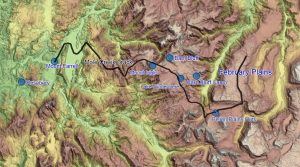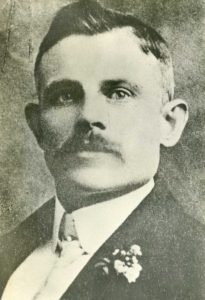Thomas Connolly left his Rosebery Hotel on Tuesday 19th March 1901 to meet prospectors James Swallow and Thomas Cook at their camp near Barn Bluff. He walked to Mount Farrell (now called Tullah), stayed overnight and then followed the Mole Creek Track towards Barn Bluff. Two days later, cold weather hit. It battered and soaked Rosebery leaving the surrounding mountains shrouded with snow. But there was no reason to fear for Thomas. He was an experienced bushman, he knew the country and he should have reached the Barn Bluff camp before the bad weather.
Meanwhile Swallow and Cook worked their mine and waited for Connolly. By the next Thursday (28th) Connolly should have reached them, so they started searching along the only track in that country, Mole Creek Track. Swallow walked west to Mount Farrell and Cook east towards Mole Creek.[1] Cook passed within a kilometre of Swallow’s old prospecting camp near Lake Windermere, past the Pelion Huts and then over the February Plains to Mole Creek.

Swallow reached Mount Farrell within a day. He would have been told that Connolly had left from there more than a week before. He knew that Connolly was in trouble. Swallow immediately telegrammed the police at Rosebery. That night Constable Patrick Harrington formed a search party and headed to Mount Farrell. Word would have also gone to Thomas’ wife, Agnes.

The police and volunteers left the next morning.[2] The search party was 12 men.[3] They headed towards Barn Bluff and into the teeth of another band of bad weather. Their hope for Connolly was that he was camped at Lake Windermere or that he may have missed the Barn Bluff camp and walked on to huts at the Pelion Plains or even to Mole Creek.[4] Later that day Cook reached Mole Creek without finding any sign of Connolly between Barn Bluff and Mole Creek.[5]
For Agnes Connolly and Thomas’ brother Denis hope was retreating fast. Thomas had not been sighted by anyone on the busy Mole Creek Track in the 10 days since he left Mount Farrell. On the 30th Denis Connolly left Queenstown to join the search. He reached Mount Farrell and went out with a second search party on Tuesday 2nd April. Searchers also set out from Deloraine.[6]

Later that day Denis Connolly met Constable Harrington and his returning search party at the foot of Mount Inglis. These two men would be the backbone of the search for Thomas Connolly.
Harrington and his men had searched for 6 days in very rough weather. They ‘thoroughly done up’.[7] Harrington had found Thomas’ swag at Swallow’s old camp at Lake Windermere but no other sign. The swag confirmed that Connolly had almost reached is his destination but also meant that he was in trouble. Where ever he was he no longer had his bedding, supplies and matches.
As Denis Connolly and Harrington shared their information, they would have looked across the plains past Barn Bluff, Lake Will and towards Mount Oakleigh and Mount Pelion East. This was the search area. Harrington would have explained that he had searched the region and then followed the Mole Creek Track as far as the Pelion Plains huts without finding any other sign of Thomas. They hadn’t searched beyond the Pelion Huts because it was inconceivable that a hungry and cold man would go past them without seeking shelter and help. It may have been remote but the track and the huts were busy with miners, prospectors and packers.
The View East from Mount Inglis (P Brown)
Harrington and his search party brought the first news to Mount Farrell. All that anyone knew for certain was that Connolly had reached Lake Windermere two weeks before and vanished.[8] He ‘had faint hopes of finding Connolly alive’. [9]
The newspapers were alive with the story including a ‘pathetic’ note written that Harrington had left at the camp at Barn Bluff.
To Mr. Connolly. Search party out since 28th March, looking for you. Your brother Denis out, found your swag in Swallow’s old tent, and fetched it to Farrell. If you do turn up try your utmost to send word to Farrell.
They hoped that somehow Connolly would reach the camp. It was stocked with food and kindling for a fire.[10]
Harrington was worn out from the search but he went straight to Zeehan to talk to his superiors. A third search party would be sent out. On Tuesday 9th April, eight men including Constable Harrington and James Swallow left Zeehan. [11] Swallow had the best knowledge of the Barn Bluff area. No one expected to find Connolly alive, some didn’t expect his body to be found either.[12]
The third search party encountered the bulk of the second returning. Denis Connolly and a few other determined men remained in the field.[13] This time the two search parties had no news to exchange. They had searched the gorges and valleys around Barn Bluff and Lake Windermere. They knew that there was no point calling out. By now Connolly would be lying dead somewhere, his body possibly huddled desperately in some protected and secluded spot.
Slowly the searchers returned as provisions and hope ran out. On the 12th April, five men returned and on the 15th Constable Marshall and six men from the third search team came back to Mount Farrell on 15th April. [14]
By now only Denis Connolly, Constable Harrington, Swallow and one other were the last searching, still desperate to find Thomas’ body and leave no option unexplored. Everyone had been working in difficult conditions with rain and snow sweeping the country.[15]
On Wednesday 17th April, Swallow returned to Zeehan.[16] The next day the last of three searchers returned. Harrington wired his superior Sub-Inspector Browne,
Party has returned to Farrell without success. Country searched for a radius of six to eight miles in all directions. Over 12 inches (30 cm) of snow on the ground. Took us 12 hours to get in. Hard time of it.[17]
After more than two weeks, the official search was over.[18] No one had done more than Denis Connolly and Harrington. Denis had spent 16 days without a break in the wild and Harrington had led 2 groups and spent two weeks looking.
The Tasmanian News concluded that ‘the Police Department has given great satisfaction on the Coast; every move denoted promptitude and humanity’. They commended ‘those members of the police force who are often called upon to bear great hardships and privation upon a beggarly pay.[19]
At Rosebery, and beyond, Thomas’ fate was ‘the all-absorbing topic’ and the ‘theories as to what had become of him were … numerous and hazardous’.[20] Some people dissected every clue, others speculated wildly. There was a report that ‘the tracks of the derelict were traced through the snow and leading to a small lake not far from Barn Bluff’.[21] On 26th March a track cutting party near Lake St Clair saw a fire lit near the Du Cane range, well south of Barn Bluff, on two nights. They were concerned enough to light a large fire in response.[22]
Murder was suggested and there was even a suspect but no evidence. And a final speculation was that Connolly was alive and well in Perth in Western Australia. This was ruled out by his relatives.[23]
In August 1901, still without knowing where Thomas lay, Agnes Connolly applied to wind up his financial affairs.[24] She could only go about her life as best she could with a hotel to run and two young children to raise.
Ian Hayes and Peter Brown
Copyright MountainStories.net.au 2019
Part 3 – A Gruesome Discovery
[1] The Examiner, 3 April 1901.
[2] Zeehan and Dundas Herald, 30 March 1901, Mercury, 30 March 1901
[3] The searchers included Martin Connolly, Jack Machyefski, P Hughes, E Midwood, J Elliot, J Kelly, Robert Peters, B Griffin and W White, Zeehan and Dundas Herald, 8 Apr 1901, p 2
[4] Zeehan and Dundas Herald, 30 Mar 1901, p 2
[5] Examiner, 3 Apr 1901, p 2
[6] Examiner, 4 Apr 1901, p 6; With Denis Connolly was M. Thornton. P. Hill, M. Donohoe, L. Hardwick, A. Wing, G. Harris, A. Neasie, W. Reardon, G. Brown, G. Hodge, Hedley Propsting, and Andrews, Zeehan and Dundas Herald, 8 Apr 1901, p 2
[7] Zeehan and Dundas Herald, 5 Apr 1901, p 2
[8] Examiner 4 Apr 1901, p 6
[9] The Examiner, 4 April 1901.
[10] Mercury, 20 Apr 1901, p 5
[11] The group was Constable Marshall and Harrington, James Swallow, J Billinghurst, Thomas Bentley, Jack Mitchell, George Harris and Charles New, Zeehan and Dundas Herald, 8 Apr 1901
[12] Zeehan and Dundas Herald, 10 Apr 1901, p 2
[13] The Mercury, 16 Apr 1901, p 2
[14] Zeehan and Dundas Herald, 13 Apr 1901, p 2
[15] Zeehan and Dundas Herald, 16 Apr 1901, p 2
[16] Daily Telegraph, 18 Apr 1901
[17] Tasmanian News, 19 Apr 1901, p 4
[18] Zeehan and Dundas Herald, 19 Apr 1901, p 2
[19] Tasmanian News, 19 Apr 1901, p 4
[20] Zeehan and Dundas Herald, 11 Apr 1901, p 2
[21] North Western Advocate and Emu Bay Times, 10 Apr 1901 p 2
[22] Zeehan and Dundas Herald, 13 May 1901, p 2. The Mercury, 13 May 1901, p 2
[23] Bendigo Independent, 7 Dec 1901, p 4
[24] Tasmanian Archives and Heritage Office, Files Relating to the Administration of Intestate Estates, SC389/1/281, Agnes Connolly Statutory Declaration 6 Aug 1901.
